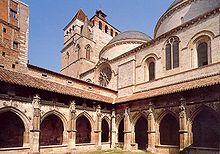Cahors Cathedral
The Saint-Étienne cathedral is the main church of Cahors and mother church of the diocese of Cahors . The cultural monument was classified as a monument historique in 1862 and placed under monument protection. Since 1998 it has been listed as part of the UNESCO World Heritage “Camino de Santiago in France” and is traditionally one of the most important stops on the Via Podiensis .
description
Two large pendent domes tower over the Romanesque nave . They form the most extraordinary example of this "aquitanic" design: they are 16 meters in diameter and 32 meters high, only Hagia Sophia has an even higher church dome. The domes rest on six almost square pillars with a side length of almost 4 meters. The adjoining semicircular choir has three chapels. The north and south sides of the nave each have a Romanesque portal, the northern one in particular is richly designed. Color effects are achieved with different types of stone, the tympanum shows the Ascension of Christ and Saint Étienne, the patron saint of the church. The archivolts are decorated with hunting scenes. The building ends with three towers on the west side and a large rose window opens in the middle of the facade .
The secco paintings in the western dome were made by Pope John XXII , who came from Cahors . in the 13./14. Commissioned in the 19th century. Stylistically, they are comparable to the paintings in the Papal Palace in Avignon . During restoration work in the 19th century, only they could be saved; those in the eastern dome had already been largely destroyed after the entire interior of the church had been whitewashed in the 18th century.
The Gothic cloister on the south side of the nave dates from the beginning of the 16th century. It was built in place of an older, Romanesque cloister and is richly decorated in the flamboyant style. On its east side is the Saint-Gausbert chapel, which houses the church treasure.
history
Construction must have begun in the late 11th century, as the main altar was inaugurated on July 27, 1119 by the newly elected French Pope Kalixt II (also Calixtus II). The main commissioner is the bishop Geraud de Cardaillac (1083–1112). He furnished the church with a relic brought back from the Holy Land (la Sainte Coiffe?) And thus gave it a role as a station on Via Podiensis , one of the French sections of the Camino de Santiago to Santiago de Compostela .
This makes Saint-Étienne, along with the Saint-Front cathedral in Périgueux, one of the oldest domed buildings in the historic Aquitaine region (including Quercy ). In the 13th century, the rear of the original three domes collapsed and was never rebuilt. A Gothic choir was built in its place from 1280 . At the same time as the new choir was built, the cathedral was given a bulky western building. It is an expression of the city's economic success during the years of the episcopate of John XII. The old Romanesque main portal was moved to the north side.
Another construction phase was the years after the Hundred Years War , when the choir chapels and the cloister were built after 1480, and the chapter buildings and the palace of the archdeacon were renovated in the Italian Renaissance style in the 16th century . The 18th century archbishop's palace was converted into a prefecture at the time of the French Revolution.
organ
The organ was built in 1714 by the organ builder Jean-Francois L'Épine. The instrument has been revised several times and today has 41 stops on three manuals and pedal. The game actions are mechanical, the stop actions are electric.
|
|
|
|
||||||||||||||||||||||||||||||||||||||||||||||||||||||||||||||||||||||||||||||||||||||||||||||||||||||||||||||||||||||||||||||||||||
See also
literature
- Thorsten Droste: Romanesque Art in France . DuMont, 1989, ISBN 3-7701-2009-4 .
- Rolf Legler: Southwest France . DuMont, 1994, ISBN 3-7701-3183-5 .
Web links
- WHC Nomination Documentation (PDF, 88.9 MB) Application documents for the nomination as World Heritage, here: section "Cahors, Cathédrale Saint-Etienne"
- Cahors Cathedral. In: Structurae
Individual evidence
Coordinates: 44 ° 26 '50 " N , 1 ° 26' 35" E




